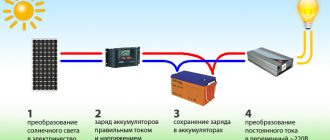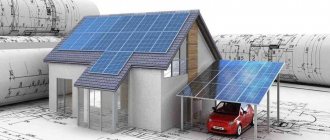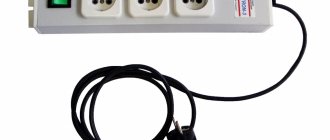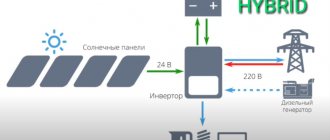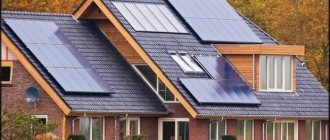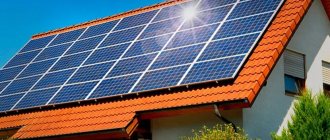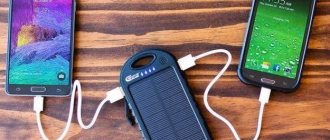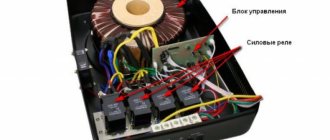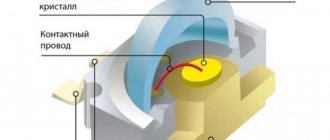Currently, alternative energy is becoming more and more firmly integrated into the everyday life of modern people, and there are several reasons for this. This is both the environmental safety of such production and the opportunity to create an autonomous power supply system, which, after the payback period has expired, can bring a certain income to the user.
One of the types of electrical energy production that uses an alternative and renewable source is solar energy, and one of the devices that ensures the operation of a solar power plant in automatic mode is an inverter.
Why is it needed?
The operation of a solar power plant as a main or backup source of power supply involves connecting a certain amount of load, which includes household appliances and technical devices that require 220/380 V alternating current to operate.
In turn, the solar battery (panel) generates direct current with a voltage of a lower order, through which the batteries that are part of the solar power plant (storage devices for generated electricity) are charged.
The operating diagram of a solar power plant is shown in the figure:
In order to convert the electrical energy accumulated in batteries into parameters corresponding to the parameters of the connected devices, technical devices called inverters are used.
Domestic
The widest range of converters is created by MAP "Energy" (from 800 to 1200 W).
The Russian company produces several lines of these devices:
- sinusoidal with an output signal in the form of a pure sine wave - MAP SIN. Their price is 22,800-130,500 rubles;
- sinusoidal with additional energy taken from batteries - MAP HYBRID, costing from 29,700 to 166,500 rubles;
- 3-phase - HYBRID MAC, suitable for charging all types of batteries using high-power charging.
Inverters of this brand are designed for private households and industrial facilities, and are used quite actively in the construction industry, medicine, and at meteorological stations.
A huge achievement is the inverter with a record power of 20 kW, which can withstand a huge load of 25 kW. It is capable of providing electricity to a multi-story building with a large number of equipment.
Types of Solar Inverters
Inverters for solar power plants are produced in various designs and differ from each other in technical characteristics, cost and availability of automation and protection equipment. But there are only three types of such devices, which determine their ability to work in relation to the traditional power supply network (from energy supply organizations), these are:
- Autonomous (“off grid”) – capable of operating only separately from external electrical networks, used for autonomous power supply systems.
- Network (“on grid”) – operate in synchronous mode with an external power supply network. Inverters of this type, in addition to their main function (voltage conversion), control the quality of electrical energy from the external network (voltage and frequency), and are also capable of transferring excess generated energy for sale to the external power supply network.
- Hybrid (“hybrid”) – combine the functions of stand-alone and networked devices and have a large number of settings that allow you to adjust various operating modes.
TOP 1: MAP HYBRID 243X3
Characteristics
- Number of phases – 3;
- Maximum power – 9 kW;
- Peak value – 15 kW;
- Recommended total power – 100 W;
- Frequency – 50 Hz;
- Operating temperature – minus 25 – plus 50;
- Size – 630x370x510mm;
- Weight – 61.5 kg.
Compatibility
The model of a three-phase hybrid inverter is compatible with electric solar stations and the household network, characterized by an enviable efficiency value. If there is no voltage in one of the phases, the remaining two will continue to transmit it to the network, and generation will be carried out by the battery.
The operation of the system does not change. Moreover, it will continue even when the network in 3 phases completely disappears. In this option, a hybrid inverter for solar panels will use generation from the battery. At the output 380 V is present in any case.
Inverters, when changing frequency, maintain communication with each other and with the generator, and can smoothly adjust to the existing frequency.
Important: the duration of operation when the peak power value is reached is 5 seconds, and the value exceeding the nominal value (autonomous mode) is 20 minutes.
Price
You can buy a hybrid solar inverter inexpensively in online stores:
| Where can I buy | Price in rubles |
| https://gws-energy.ru/invertory/gibridnye-invertory/by,product_sales?keyword= | 176700 |
| https://www.invertor.ru/zzz/item/map_hybrid_24_3_x3 | 176700 |
| https://www.invertor.ru/zzz/item/map_hybrid_24_3 | 58900 |
| https://www.invertor.ru/zzz/orderform | 58900 |
| https://iprojector.ru/catalog/elektrooborudovanie/?id=58184&PAGEN_1=4 | 176800 |
Network type inverters
A distinctive feature of network inverters is the nature of their operation in relation to the external electrical network.
Devices of this type are installed in the electrical circuit between the solar panel and the 220/380 V electrical network. Installation of a network inverter involves the operation of a solar power plant without the presence of energy storage devices (batteries), when the current generated by solar panels goes to power individual consumers connected directly to the inverter, and surplus - to the external network. The operation of such a device is carried out only during the daytime, when there is sunlight.
Filter
Manufacturer
- SmartWatt
- Stark
- Sunways
- MicroArt
Active power
- 1.3
- 2
- 3
- 4.5
- 6
- 9
- 13.5
- 15
- 18
- 20
- 27
- 45
- 60
Capacity, Ah
- 4x100
Inverter power, kW
Show value(s)
Power, W
- 3000
- 5000
Apparent power, VA
Show value(s)
Battery type
- GEL/AGM maintenance-free
Type of solar cells
Show value(s)
Maximum charge current, A
- 25
- 30
- 50
- 60
- 140
Max power 12/24/36/48V, W
- 500
- 600
- 1000
- 1500
- 4000
- 6000
Inverter power, W
- 3000
- 5000
Autonomous inverters
Autonomous type inverters operate as part of solar power plants that provide autonomous power supply to consumers of electrical energy. Technical devices of this type convert the energy accumulated in batteries to the required parameters and ensure reliable autonomous power supply.
Depending on the shape of the output current signal, inverters of this type are divided into: sinusoidal and quasi-sinusoidal.
Sine wave inverters have better technical performance, but are larger in size and cost than quasi-sine wave inverters, which determines the scope of their use and distribution of such devices on the market.
Where is it used?
The hybrid inverter is in demand in households when it is necessary to reserve the main power source and ensure uninterrupted supply of electricity.
More powerful equipment is used at power plants to supply electricity at a feed-in tariff.
Scope of application:
autonomous power supply at home;
The scope of application of the hybrid inverter is constantly expanding, but it is limited by the high cost of the equipment.
Main technical characteristics
When choosing the type of inverter and the possibility of installing it in a particular power supply circuit, the main parameters determining the choice are its technical characteristics, which are:
- Power – determines the amount of load (appliances and devices) that can be connected to a specific device. Rated power indicates the long-term permissible load, when connected, the inverter is able to operate for a long time. The maximum permissible (peak) power determines the ability to convert electric current for a short period of time, at the moment of starting electric motors or other devices, when turned on, a jump in the electric current occurs (starting current).
- The type of output signal (sine wave shape) determines the possibility of connecting this or that equipment to a specific inverter model. When using cheaper devices with a quasi-sinusoidal electric current signal, difficulties may arise during the operation of devices and units that are sensitive to the quality of electric current (heating boilers, pumps, electronic devices).
- Input and output voltage - determines the possibility of installation with a certain type of solar panels that generate electric current with a voltage of 12/24/48 V, and in accordance with this, the voltage of the consumer power supply network is 220 and 380 V.
- The presence of protective elements depends on the specific device model. The main types of protection are short circuit and overload protection.
- Additional options – also depends on the device model. This could be the installation of a built-in socket, liquid crystal display, charger and other elements.
Criteria taken into account when choosing
Along with the geometry of the output signal, it is also affected by its power.
Important: When choosing one of the main elements of batteries powered by solar energy, you need to proceed not only from the optimal geometry of the output signal: you must take into account the power. It is recommended to equip them with converters whose power value is higher than that of the equipment used by the consumer. The reserve must be at least 30 percent. It is also necessary to take into account the one-time load that occurs when several devices with high starting power are turned on simultaneously.
An important criterion is considered to be efficiency, which characterizes the associated energy losses. It varies for different devices and lies in the range of 85-95%. The optimal value is considered to be 90%.
Popular models
Each user chooses for himself which model to choose and where to buy it. Of course, the best place to select and purchase complex technical devices, such as a solar inverter, are dealers of manufacturers of such products, but they are not present everywhere, so you can use the Internet, where you can find a model that meets the requirements for it.
Currently, the most popular series and models are:
- "SibVolt" (Russia) - network inverters, rated power from 1.5 to 3.0 kW, voltage 12/24/48 V.
- “Sunrise” (China) – hybrid type, rated power 3.2 and 4.0 kW, voltage 48 V.
- “UMA” (Russia) – autonomous type, rated power from 2.4 to 4.0 kW, voltage 24/48 V.
- “S300” (Taiwan) – autonomous type, rated power 300.0 W, voltage 12/24 V.
- “Stark Country” (China) - hybrid type, rated power from 1.6 to 4.0 kW, voltage 12/24/48 V.
- “Sunville SV15000s” (Russia) – network device with a rated power of 15.0 kW.
Series and specific models on the market for similar products are represented quite extensively, both in terms of technical characteristics and the companies that produce them. In this regard, it is always possible to select a device in accordance with the personal wishes of the user based on the selection criteria discussed below.
Foreign
The most famous are converters developed in France by Schneider Electric, which are famous for their performance parameters that make them suitable for use in areas with different climates. Their body is protected from corrosion by a special coating.
Conext from Schneider Electric
They were developed to improve the efficiency of batteries installed on the roofs of buildings. They can be used even in the most difficult climatic conditions. Efficiency reaches 97.5%, power is in a wide range - 3-20 kW.
The price range is 86900-327300 rubles.
Purpose
It is designed for installation on the roofs of high-rise buildings and country cottages.
Reliability
During manufacturing, inverters undergo strict quality control using various techniques and tests.
Design
It does not contain electromechanical capacitors, which dramatically increases the reliability of the devices and increases their service life. Even with maximum load, the device achieves an efficiency of 97.5 percent. Some models do not have a distribution block, therefore, installation of an electrical panel is not required.
From a huge range of devices with a power of 3-20 kW, everyone will choose the most suitable model.
How to choose the best?
As mentioned above, on the market for such devices there are a large number of models from different manufacturers that are similar in their technical characteristics. In order to choose an inverter without making a mistake, you must follow the selection criteria, which are:
- Rated power.
- Maximum (peak) power.
- Current output waveform.
- Efficiency
- Operational indicators (temperature, humidity, installation altitude above sea level).
- Voltage at the “input” and “output” of the device.
- Availability of protection against short-circuit currents and overloads.
- Availability of sleep mode, cooling fan and additional options.
- Dimensions and weight.
- Brand and reliability of the manufacturer.
- Price.
Based on the above criteria and knowing the network parameters, each user is able to independently choose the best model from those currently presented in a specific region or on Internet resources.
Choice
Basic selection options:
- peak, rated and load power;
- efficiency;
- weight of the device;
- temperature regime.
- In addition, you should ask whether there is protection against:
- possible overloads and overheating;
- from short circuit;
- voltage supplied from batteries (low and high).
Important: technically, it is easy to evaluate the performance of an inverter, knowing its weight, if you know that per 100 watts of output power there is a kilogram of device mass.
Connecting the inverter to the solar battery
An inverter is a device that works in conjunction with other elements of a solar power plant, which are:
- Solar panel is a source of electrical energy;
- Rechargeable battery – storage of generated energy;
- Charge controller - is responsible for the condition of the batteries, controls their operating mode - “charge-discharge”;
- Wires and cables – ensure the connection of all devices into a single electrical circuit;
- Load-bearing structures - provide reliable fastening of the mounted equipment; some devices allow you to adjust the position of solar panels in space, in accordance with the location of the sun.
Connecting an inverter to the operating circuit of a power station depends on the type of device, i.e. ability to work in relation to an external electrical network.
The connection, depending on the type of inverter, is made according to the following scheme, for:
- Autonomous (“off grid”) models.
Models of this type are installed between the load and the battery, which is also charged through the inverter contacts. Some models, as shown in the figure, may have a separate input for connecting to an AC electrical network to charge the batteries if they cannot be charged from solar panels.- Network (“on grid”) models.
Inverters of this type are included in the electrical circuit between the solar panels and the load elements and the external electrical network. This type of device does not provide for connecting batteries. In cases where the amount of generated electrical energy exceeds the required values, the excess is redistributed to the external network.
- Hybrid (“hybrid”) models.
The hybrid type of such devices involves installing an inverter between the batteries, the external network and the load at the same time. The use of an inverter in solar power plant circuits allows them to operate automatically, which greatly simplifies their use and expands their scope of application.
Correct installation
The connection diagram for solar panels is much more complex than the centralized input of the city network. A home power plant consists of at least four elements.
We do not consider primitive 12-volt garden path lighting systems. We will talk about a full power supply of 220 volts.
Actually photocells. We have already discussed the operating principle and selection criteria. Power calculations are made from a base figure of 5 kW per 1 house. This is approximately 20–40 standard panels with an area of 0.5 m². Control unit (controller). Without it, your power plant cannot function. How to choose the right charge controller for a solar battery? It must maintain the overall power of the power supply system, ensure the batteries are charged and correctly distribute the power flow with simultaneous consumption and charging. In addition, the controller is responsible for the safety of the system, including fire safety. The device can be included in the power station kit or purchased separately. The functionality of all models is standard. When choosing, you determine the power, voltage (12 or 24) and the main criterion - service life (warranty). If the controller fails, your power supply is determined by the capacity of the batteries (until they are discharged). Battery module
Perhaps the second most important element in the “power plant”. It serves as a storage buffer for the power system
In fact, power is taken from the batteries. Solar cells only restore the supplied energy reserve (charge the battery). Of course, there may be periods when part of the load falls on the solar cells (if the energy generated is significantly higher than the charging costs). Then we can say that your TV or refrigerator is powered directly by the sun. Before installing solar panels, it is necessary to calculate the battery capacity. This is done simply: with an input power of 3 kW, the current consumption does not exceed 15 A (in a 220 volt network). At the output of 12 volt batteries, the current will be already 250 A (in accordance with Ohm’s law). Of course, such power is not taken out constantly, but for the sake of example in the calculations we will take these figures. That is, if you install 5 batteries with a capacity of 100 Ah each, then with such a load the charge will end in 2 hours. Of course, these are conditional figures: in reality, there are many corrections in the calculations. But the base current and power are calculated precisely according to this principle. There are various batteries: acid, alkaline, gel... By and large, there is no point in chasing the most “advanced” systems. And you can only save on the possibility of maintenance: batteries that require supervision are cheaper. Voltage transformer. You can take power directly from the battery if your consumers are designed for 12 volt power. However, most electrical appliances are designed for 220 volts. Therefore, a 12–220V converter is installed at the output. Your internal electrical network is connected to it.
Types of current converters
When choosing the “heart” of an autonomous power supply system, you should correctly compare the tasks assigned to the equipment with its potential capabilities.
The main features of the classification of hybrid inverters are: an algorithm for changing operating modes, the shape of the output voltage and the ability to service a single- or three-phase network.
Comparison of PSU and hybrid installation
Some companies unwittingly mislead consumers by calling an uninterruptible power supply unit (UPS) a hybrid inverter. It would seem that both devices perform similar tasks, but there is a significant difference.
The BPS is an inverter with a charger. The module primarily ensures energy consumption from the photovoltaic installation, and if there is insufficient energy, it switches to consumption from the network.
The UPS is not capable of performing the function of “mixing” the accumulated electricity from the batteries with the network. Priority consumption from the DC source is realized by disconnecting from the network and switching to battery operation
The functioning of the system in a “jerky” mode provokes additional cycling of the battery and accelerates its wear. In most inexpensive PSUs, the threshold voltage is set without the possibility of regulation.
In models of hybrid inverters for solar panels, such jumps are excluded - the unit adapts to the required power and works simultaneously with different current sources.
You can choose your priority consumption yourself. Typically, the emphasis is on energy consumption from solar panels. Some hybrid units have the option of limiting the power supplied from the city network.
Comparison of the functions of popular modifications of hybrid “converters” and BPS. The Victron series of models provides the ability to increase inverter power due to the network
Varieties according to the inverter signal shape
Solar cell current converters are classified by the type of output signal.
There are:
- pure sine wave;
- modified sine (quasi-sine wave);
- meander.
The latter option is practically not used in practice, since a sharp change in polarity causes malfunctions in the equipment.
An inverter that supplies a “U-shaped” signal will not be able to protect devices from voltage surges. In addition, most household appliances do not accept meander current
What is a pure sine wave?
The converter produces a high quality signal that is superior to the mains current waveform. This is the best option for ensuring the operation of “sensitive” equipment: heating boilers, compressors, electric motors, medical equipment and devices based on transformer power supplies.
Disadvantages of sine wave inverters: high cost and large dimensions. Purchasing a converter with a pure sine wave will cost twice as much as a model with a quasi-sine wave with equal total power indicators
Features of quasi-sine
Transmission of signal energy in the form of a modified sine wave can reduce the efficiency of some devices, provoke the appearance of noise, cause interference or lead to equipment failure.
When powering low-frequency transformers, asynchronous, synchronous motors, a power loss of 20-30% is visible. This “flaw” is converted into thermal energy, excessively heating the devices.
Inverters with a pseudo-sine wave signal are compact and affordable. Their use is advisable for powering devices without inductive loads, designed to consume active components of electrical power.
This group includes: thermoelectric heaters, incandescent lamps for lighting systems and other resistive structures.
Modified sine options: 1 – complicated meander shape with a pause, 2 – approaching a pure sine by increasing the number of transitions
The shape of the output signal is indicated in the passport of the inverter or uninterruptible power supply. Possible designations: “Back” – guarantee of the absence of a pure sine wave, “Smart” – probability of obtaining high-quality current at the output.
Some manufacturers note the harmonic distortion factor (nonlinear distortion index) in the accompanying document. If the parameter is less than 8%, then the unit produces an almost perfect sine.
Single-phase and three-phase models
Single-phase inverters are mainly integrated into the circuit of a residential photovoltaic system with a standard voltage of 220V.
The output voltage range when connected to one phase in different models ranges from 210-240V, output frequency - 47-55 Hz, power - 300-5000 W.
Single-phase inverters are produced for standard battery voltages: 12, 24 and 48 V. To ensure that the converter does not operate at its maximum capacity, it is necessary to match the power of the “converter” with the voltage of the solar battery or battery.
Range of dependence of battery characteristics (voltage - V) and solar converter (nominal power - W): 12 V - within 600 W, 24 V - up to 1.5 kW, 48 V - over 1.5 kW
Three-phase inverters are used to supply three-phase current to power electric motors. Primary use: production, workshops, commercial purposes.
Three-phase inverters are distinguished by high power (3-30 kW), a wide range of output alternating voltage (220V/400V).
Combination models are also available on the market. These include single-phase inverters with the ability to synchronize the converter outputs with a phase shift - this allows you to power three-phase loads. We reviewed all types of equipment for converting current from solar panels in our other article.
